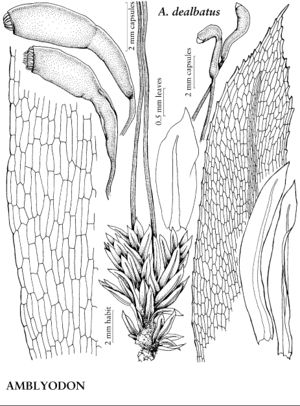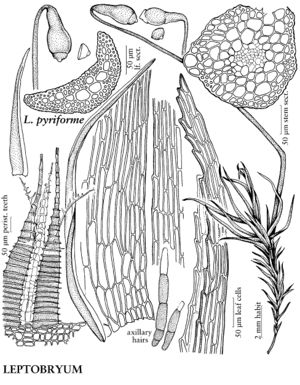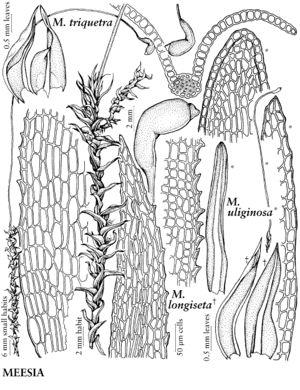Plants acrocarpous. Stems erect to ascending, simple to sparsely branched. Leaves erect-spreading to squarrose-recurved, somewhat crowded, uniform, ovatelanceolate to linear or obovate; margins not bordered; apex acute to rounded-obtuse; costa single, strong, usually ending before apex; distal laminal cells rounded-hexagonal to rectangular, smooth or mammillose. Seta slender, usually very long, to 11 cm. Capsule sometimes inclined, clavate to pyriform, sometimes curved, smooth, neck long, well defined, abruptly merging to wider urn; peristome diplolepidous, double, reduced; exostome teeth 16, shorter than endostome; endostome segments 16, cilia 0–3. Calyptra cucullate, naked.
Distribution
n North America, Mexico, West Indies, Central America, South America, Europe, Asia, Africa, Pacific Islands (New Guinea), Pacific Islands (New Zealand), Australia (including Tasmania)
Discussion
Genera 5, species ca. 12 (4 genera, 6 species in the flora).
Meesiaceae are characterized by capsules with long necks that abruptly expand into the spore sac. The acrocarpous plants generally occur on peaty substrates, have undifferentiated alar cells, long setae, and often reduced diplolepidous peristomes.
Selected References
None.
Lower Taxa
Illustrations
Key
| 1 | Leaves long-lanceolate to linear. | Leptobryum |
| 1 | Leaves ligulate, ovate-lanceolate, oblong, obovate, or elliptic | > 2 |
| 2 | Leaves squarrose-recurved; laminal cell surface bulging-conic. | Paludella |
| 2 | Leaves erect to wide-spreading; laminal cell surface not bulging | > 3 |
| 3 | Laminal cell walls lax, cells oblong-rhombic to oblong-hexagonal. | Amblyodon |
| 3 | Laminal cell walls firm, cells irregularly isodiametric to short-rhombic. | Meesia |



